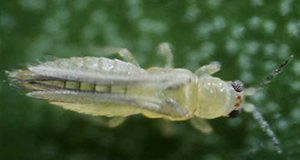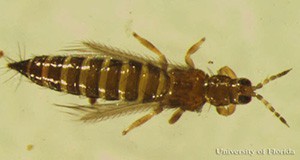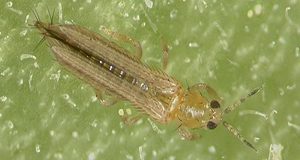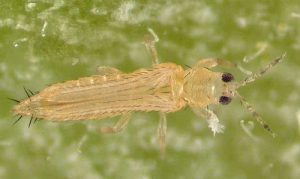Created to help growers and crop consultants, private homeowners, Master Gardeners, and the general public identify common arthropod pests and the damage they inflict, each field guide provides photos of the important life stages and crop damage associated with arthropod pests. The text highlights key general morphology and biology, distribution, and natural enemies. Written by Jeffrey Cluever and Hugh Smith, and published by the UF Department of Entomology and Nematology.
The following have been added to the existing series, http://edis.ifas.ufl.edu/topic_series_pest_identification_guides
Tag: Pest Identification Guides series
Pest Identification Guide: Western Flower Thrips Frankliniella occidentalis (Pergande)
Western flower thrips transmits the carmovirus Pelargonium flower break virus (PFBV), the ilarvirus Tobacco streak virus (TSV), and the tospoviruses Chrysanthemum stem necrosis virus (CSNV), Groundnut ringspot virus (GRSV), Impatiens necrotic spot virus (INSV), Tomato chlorotic spot virus (TCSV), and Tomato spotted wilt virus (TSWV). This species is primarily a flower feeder, so most damage would be expected on the flower or fruit. Learn to identify the western flower thrips with this two-page illustrated guide written by Jeffrey D. Cluever and Hugh A. Smith and published by the Department of Entomology and Nematology.
http://edis.ifas.ufl.edu/in1127
Pest identification Guide: Florida flower thrips Frankliniella bispinosa (Morgan)
The Florida flower thrips is a known pest of blueberry but its status in other crops is unclear. Florida flower thrips transmits Tomato spotted wilt virus and possibly other tospoviruses. This species is primarily a flower feeder, so most damage would be expected on the flower or fruit. Learn to identify the Florida flower thrips with this two-page illustrated guide written by Jeffrey D. Cluever and Hugh A. Smith and published by the Department of Entomology and Nematology.
edis.ifas.ufl.edu/in1125
Pest Identification Guide: Chilli thrips Scirtothrips dorsalis Hood

Chilli thrips transmits the ilarvirus Tobacco streak virus (TSV) and the tospoviruses Groundnut bud necrosis virus (GBNV), Groundnut chlorotic fan-spot virus (GCSFV), and Groundnut yellow spot virus (GYSV). This species primarily feeds on young, tender foliage. Feeding on foliage may result in silvering leading to necrosis, leaf curl (upward), distortion, and defoliation. Feeding on the fruit may cause scarring, discoloration, and the formation of corky texture on the fruit. Learn to identify the chilli thrips with this two-page illustrated guide written by Jeffrey D. Cluever and Hugh A. Smith and published by the Department of Entomology and Nematology.
http://edis.ifas.ufl.edu/in1124
Pest Identification Guide: An Introduction to Thrips
 Tiny insects called thrips are difficult to see with the unaided eye but cause very obvious and sometimes ruinous damage to the flowers, buds, and fruit of many important crops. This two-page guide asks and answers the key thrips questions that allow growers to distinguish between chilli thrips, common blossom thrips, and Western flower thrips to more effectively battle against these destructive pests. What does it look like? What is its life cycle? Where is it found? What type of damage does it cause? And, most importantly, who are its natural enemies? Use this guide to help you identify thrips so that you can take effective steps to control them and limit the damage they cause. Written by Nicole Casuso and Hugh Smith with photos by Lyle Buss, Jeff Cluever, Vivek Kumar, P.M.J. Ramakers, Gary Vallad, and Hugh Smith. Published by the Entomology and Nematology Department, UF/IFAS Extension.
Tiny insects called thrips are difficult to see with the unaided eye but cause very obvious and sometimes ruinous damage to the flowers, buds, and fruit of many important crops. This two-page guide asks and answers the key thrips questions that allow growers to distinguish between chilli thrips, common blossom thrips, and Western flower thrips to more effectively battle against these destructive pests. What does it look like? What is its life cycle? Where is it found? What type of damage does it cause? And, most importantly, who are its natural enemies? Use this guide to help you identify thrips so that you can take effective steps to control them and limit the damage they cause. Written by Nicole Casuso and Hugh Smith with photos by Lyle Buss, Jeff Cluever, Vivek Kumar, P.M.J. Ramakers, Gary Vallad, and Hugh Smith. Published by the Entomology and Nematology Department, UF/IFAS Extension.
http://edis.ifas.ufl.edu/in1058

